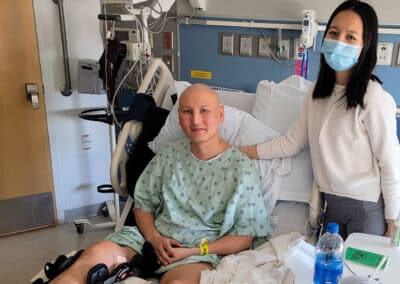Osteosarcoma is a long and difficult road, but you do not have to travel it alone.


Stories of progress, inspiration, and information in overcoming osteosarcoma.

Osteosarcoma is a long and difficult road, but you do not have to travel it alone.
The Osteosarcoma Institute (OSI) funds breakthrough research and clinical trials to uncover new treatments, all while supporting patients and families with reliable information and free expert guidance for the cancer journey.
Here is what you might expect if you have osteosarcoma, from initial diagnosis through treatment.
Diagnosing osteosarcoma is a multi-step process. It typically begins with an X-ray, which alerts doctors that there is an abnormal growth on the bone. This is often followed by advanced imaging technology to detect — with precision — the abnormality, its size, and where it is located in the body. Additional scans and tests may include:
The next step — and the only definitive way to know whether a tumor is osteosarcoma — is to take a biopsy of the affected area and test it for cancerous cells.
Once a biopsy is analyzed and osteosarcoma is confirmed, a variety of other tests may be ordered to further determine the extent of the tumor.
Treating osteosarcoma depends on the size of the tumor and its location in the body. Current therapy for osteosarcoma almost always includes a combination of standard chemotherapy treatment and surgery.
Most patients are placed on a chemotherapy regimen for several months to try to shrink the tumor before surgery. The type of surgery performed can vary, but usually includes limb-salvage surgery, which helps preserve the limb by removing the part of the bone involved with the tumor and some of the tissues that surround it. For example, a rotationplasty — a surgery for bone cancer near the knee — is one type of limb-salvage surgery.
After a patient has recovered from surgery, chemotherapy is often continued as a form of maintenance therapy to keep the cancer from recurring. Patients also begin physical therapy and rehabilitation as part of their recovery process.
With any cancer treatment, there are side effects. This is also true for osteosarcoma treatment. Chemotherapy side effects can include:
Once chemotherapy is completed, these side effects should resolve on their own. Patients who undergo surgery, especially if they receive an internal prosthesis, may also begin physical therapy as part of their recovery. Physical therapy will help guide a patient’s rehabilitation and ensure that they regain strength and movement in the safest way possible.
If the cancer comes back, following the first round of treatment, a patient may be eligible to participate in a clinical trial.
Clinical trials provide patients with access to the latest treatment methods and drug therapies that are being developed for cancer, including osteosarcoma. Most clinical trials for osteosarcoma include newer targeted therapy drugs or immunotherapy combinations, which use the body’s own immune system to prevent, control, and eliminate cancer.
The OSI established a partnership with Carebox to help connect patients with a free and confidential clinical trial matching program.
More broadly, the OSI also provides answers and assistance for any part of the osteosarcoma journey through our free patient service, OSI Connect. This service connects an osteosarcoma patient with a medical expert in the field who can answer their questions and make suggestions.

Stay informed as we work to identify new treatments for osteosarcoma.
We never sell or share your information.




Your donation provides immediate and long-term support to osteosarcoma patients.
Sign-up for our newsletter and stay up-to-date about our fight against Osteosarcoma!